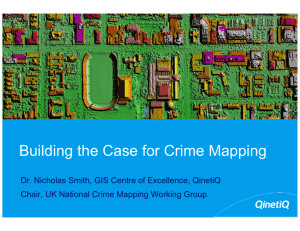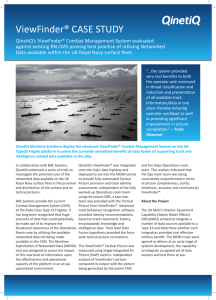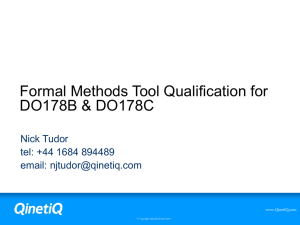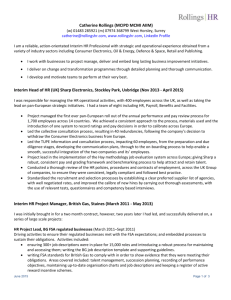Integrated Radiation Mitigation and Shielding Design
advertisement
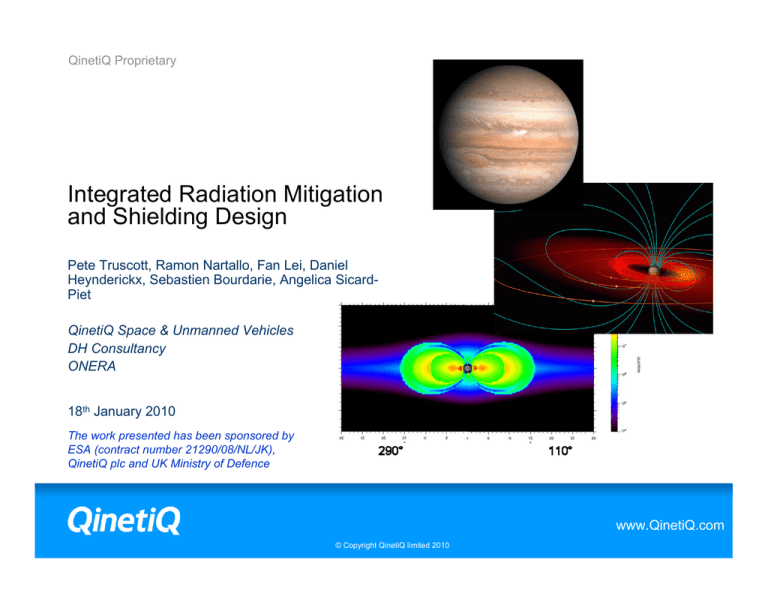
QinetiQ Proprietary Integrated Radiation Mitigation and Shielding Design Pete Truscott, Ramon Nartallo, Fan Lei, Daniel Heynderickx, Sebastien Bourdarie, Angelica SicardPiet QinetiQ Space & Unmanned Vehicles DH Consultancy ONERA 18th January 2010 The work presented has been sponsored by ESA (contract number 21290/08/NL/JK), QinetiQ plc and UK Ministry of Defence www.QinetiQ.com © Copyright QinetiQ limited 2010 QinetiQ Proprietary Effects of the Jovian Radiation Environment • Significantly enhanced radiation environment compared with near Earth − Particle energies and fluxes (electron energies beyond 100 MeV) • Total ionising dose – microelectronics, MEMS, sensors, materials • Total non-ionising dose (displacement damage) – sensors/FPA, solar arrays • Deep dielectric charging • Single event effects (upset, latch-up, burn-out, gate-rupture, etc) • Several standard tools are not intended for use in this regime: − SHIELDOSE (10MeV) and SHIELDOSE-2 is based on Monte Carlo data for up to 50MeV − EQFLUX • Environments in vicinity of Galilean moons www.QinetiQ.com © Copyright QinetiQ limited 2010 2 QinetiQ Proprietary Effects of the Jovian Radiation Environment Comparison with MEO (GIOVE solar max, 939 days) 1.E+09 Total ionising dose [rad(Si)] 1.E+08 Laplace total Laplace trapped e- Laplace brems Laplace trapped protons Laplace solar protons GIOVE total GIOVE trapped e- GIOVE brems 1.E+07 Laplace total and trapped electrons 1.E+06 1.E+05 GIOVE total and trapped electrons 1.E+04 1.E+03 0 5 10 15 20 Al shield thickness [mm] Data from J Sørensen and G Santin (Laplace), and QinetiQ (GIOVE, VALCOMPT project) www.QinetiQ.com © Copyright QinetiQ limited 2010 3 QinetiQ Proprietary Review of mitigation measures • Shield − Judicious positioning of more sensitive equipment to shield using less sensitive systems − Compact system distribution − Addition of deliberate shielding (at equipment box level, spot shielding, thicker cover glasses …) − “Radiation vault” design • Component and technology selection − Radhard / Rad-tolerant − Exploit difference in tolerances due to different commercial designs − Watch-out for potential effects of new (especially high-Z materials) introduced in microelectronics! • Hardening at circuit level − Less susceptible to effects of e.g. voltage shifts − Circuit compensation for e.g. threshold shifts, gain drift − EDAC www.QinetiQ.com © Copyright QinetiQ limited 2010 4 QinetiQ Proprietary Review of mitigation measures • Provision for annealing − Particularly for scientific instrument technologies • Duty cycling & cold redundancy − Mitigate some TID effects by unpowering equipment during intense irradiation periods • Hide Mitigation for internal or deep dielectric charging • Shield • Reduction in material thickness / selection of dielectric • Ensure common grounding • De-rating of electrical/electronics systems (reduce-f, filter) • Avoid cold temperatures www.QinetiQ.com © Copyright QinetiQ limited 2010 5 QinetiQ Proprietary Shielding and influence of shielding materials • Shielding in context of Al? Why? • High-Z materials better at scattering electrons • However, per unit mass, high-Z materials also − Have lower stopping powers (fewer electrons per unit mass) − Generate more bremsstrahlung (cross-section scales as Z2) • Graded shields use combinations of low and high-Z materials to: − Efficiently stop electrons with low bremsstrahlung production (low-Z) − Efficiently absorb any bremsstrahlung, and scatter any residual low-energy electrons (1) Sensitive volume (2) e e- (3) e (4) e Low-Z Hi-Z Low-Z − Absorb any residual photoelectrons or Auger electrons • Provide significant mass-saving for electron environments www.QinetiQ.com © Copyright QinetiQ limited 2010 6 QinetiQ Proprietary Graded shielding example for GIOVE orbit 1 year at solar maximum 1.E+07 1.E+06 eqv 1.0 mm Al eqv 1.5 mm Al eqv 2.0 mm Al eqv 2.5 mm Al Total ionising dose [rad(Si)] Total ionising dose [rad(Si)] Eqv. 0.2-0.8 mm Al 1.E+06 1.E+05 eqv 0.2 mm Al eqv 0.3 mm Al eqv 0.4 mm Al eqv 0.5 mm Al eqv 0.6 mm Al eqv 0.8 mm Al 1.E+04 0 20 40 60 80 100 Eqv. 1.0-2.5 mm Al 1.E+05 1.E+04 1.E+03 0 Percentage aluminium by weight 20 40 60 80 100 Percentage aluminium by weight Total ionising dose [rad(Si)] 1.E+05 Eqv. 2.5-5.0 mm Al 1.E+04 1.E+03 eqv 3.0 mm Al eqv 3.5 mm Al eqv 4.0 mm Al eqv 4.5 mm Al eqv 5.0 mm Al 1.E+02 0 20 40 60 Percentage aluminium by weight 80 100 © Copyright QinetiQ limited 2010 www.QinetiQ.com 7 QinetiQ Proprietary Graded shielding example for GIOVE orbit 1 year at solar maximum 50% Pure aluminium shield Pure tantalum shield Optimised shield Optimised/Pure-Al TID 1.E+06 45% 40% 35% 1.E+05 30% 25% 1.E+04 20% 15% 1.E+03 10% 5% 1.E+02 Optimised shield TID / Pure Al shield TID Total ionising dose [rad(Si)] 1.E+07 0% 0.1 1 10 Equivalent thickness of aluminium [mm] www.QinetiQ.com © Copyright QinetiQ limited 2010 8 QinetiQ Proprietary Radiation dose versus depth in spherical Al shields 1.E+08 Total Trapped electrons Bremsstrahlung Trapped protons Solar protons Total ionising dose [rad(Si)] 1.E+07 1.E+06 1.E+05 1.E+04 1.E+03 0 5 10 15 20 Al shield thickness [mm] Data from J Sørensen and G Santin www.QinetiQ.com © Copyright QinetiQ limited 2010 9 QinetiQ Proprietary Comparison of TID for Al, Fe and Ta slab shields NOTE: Based on earlier (Jan 2009) spec for environment Ganymede science mission dose [rad(Si)/day] 1.E+04 Al slab sield Ta slab shield Fe slab shield 1.E+03 This requires further, more thorough analysis 1.E+02 1.E+01 Note this is at expense of higher bremsstrahlung 1.E+00 0 2 4 6 8 10 Equivalent thickness of Al for similar mass [mm] www.QinetiQ.com © Copyright QinetiQ limited 2010 10 QinetiQ Proprietary Beware of dose enhancement effects In environments which are photon / bremsstrahlung-dominated, dose enhancement effects are a risk • High-Z materials produce low-energy photo- and Auger e- in bremsstrahlung environment • Very localised enhancement of dose • Au contacts, W-vias and silicides (WSi) e- Au Si www.QinetiQ.com © Copyright QinetiQ limited 2010 11 QinetiQ Proprietary Beware of dose enhancement effects • Detailed Geant4 microdosimetry analysis performed for Cu metallization layer • Need to use MC tools like MULASSIS Cu metallisation Al metallisation Cu/Al 1.E-08 8 7 6 5 1.E-09 4 1.E-10 3 2 1.E-11 Note: Most TID testing performed near this energy 1.E-12 1.E+00 © Copyright QinetiQ limited 2010 1.E+01 1.E+02 Photon energy [keV] Dose enhancement factor Cu/Al Dose per unit fluence [rad(SiO2)cm2] 1.E-07 1 0 1.E+03 www.QinetiQ.com 12 QinetiQ Proprietary ESA JORE2M2 Project (Jovian Radiation Environment and Effects, Models and Mitigation) Objectives • Assess the requirements for radiation and plasma environment models, and effects and mitigation tools for future Jupiter-system missions (including Jupiter flyby). • Review the available models and tools used to predict the Jovian radiation and plasma environments and their effects, and identify a strategy for software development and update. • Design, develop, validate and install at a model for predicting the environment within the Jovian magnetosphere (including the Galilean moons), and effects and mitigation tools. The tools shall permit assessment of radiation-related quantities for engineering purposes, including where possible, confidence levels. • All tools and models will be such as to allow operation over the Internet (World-Wide Web), and are to be compatible data interfaces with SPENVIS. www.QinetiQ.com © Copyright QinetiQ limited 2010 13 QinetiQ Proprietary Effects Tools Questionnaire Which existing models do you know or which ones do you use to define Jupiter radiation environment? Current use: Relevant for future use: • SHIELDOSE / SHIELDOSE-2 • MULASSIS • SSAT • GEMAT 1 1 • FASTRAD 5 2 • OMERE 3 1 • DOSRAD 3 2 • NIEL (within SPENVIS) 4 2 • EQFLUX 2 1 • GRAS 2 2 • DICTAT 6 3 • Others include SPIS, Tiger/MCNP, NUMIT 8 4 6 2 2 2 www.QinetiQ.com © Copyright QinetiQ limited 2010 14 QinetiQ Proprietary Effects Tools Questionnaire Which radiation effects are you interested in and what are their relative importances? Not imp. : Quite imp.: Very imp.: • Total Ionising Dose (TID) 0 1 9 SD2/ML • Non-Ionising Energy Loss (NIEL) 0 5 5 ML 2 1 5 (to microelectronics) • Non-Ionising Energy Loss (NIEL) EQFLUX (to solar arrays) • Single Event Effects (SEE) 8 GEMAT 0 2 • Sensor background effects 2 2 6 GEMAT • Surface charging 1 4 4 • Deep-dielectric charging 1 3 6 DICTAT • Need both web-based tools and local applications which deal with radiation effects Other:formaterial degradation • Operating systems: ~75% Windows, ~25% Linux (but also one expression of interest in Mac-based solution!) www.QinetiQ.com © Copyright QinetiQ limited 2010 15 QinetiQ Proprietary JORE2M2 Project Integrated Solution for Environment and Effects Simulation for Jupiter Missions • Coherent set of interfaced tools to simulate environment and effects in a SPENVIScompatible framework • JOSE for energetic environment, and Divine + Garrett plasma models • Requirement to extend existing engineering tools, in particular generate new SHIELDOSE-2 database which: − Extends the energy range for electrons to >50MeV − Allows treatment of non-Al shields • Allow modelling of radiation environment at moons, taking into consideration influence of intrinsic and induced fields as well as structure of the moons (PLANETOCOSMICSbased) • Development of genetic algorithm software to optimise 1-D shields (composition and thickness) • Standard tools such as DICTAT and GEMAT are also to be available within Framework www.QinetiQ.com © Copyright QinetiQ limited 2010 16 QinetiQ Proprietary SHIELDOSE-2 Enhancement Shield and target materials Shield materials • Al, Ta, Fe • 1mm Al followed by Ta • CW80 and Ti Targets - Materials in which energy is considered deposited (TID) • Al, Si, H2O, SiO2, C (graphite), bone, CaF2, GaAs, LiF, tissue (in SHIELDOSE-2). • plastics to represent polyimide (C22H10O5N2 1.42 g/cm3), and epoxy (C18H19O3, 1.85 g/cm3). • HfO2, SiC, and InGaAs (assumed In0.5Ga0.5As), HdCdTe (assumed to be Hg0.7Cd0.3Te for MWIR sensors), NaI, MgO, CdZnTe (Cd0.96Zn0.04Te for LWIR sensors) and Ge. Targets - Materials in which energy is considered deposited (TNID) • Si and GaAs (based on ECSS-E-10-12 NIEL coefficients) www.QinetiQ.com © Copyright QinetiQ limited 2010 17 QinetiQ Proprietary SHIELDOSE-2 Enhancement Dose predictions for Ta slab shield: Laplace science mission (Env specification v1.0) Ganymede mission TID [rad(Si)/day] 1.E+04 MULASSIS Dose: 0.5-100MeV SHIELDOSE-J Dose: 0.5-100MeV SHIELDOSE-J Electron Dose 1.E+03 1.E+02 1.E+01 1.E+00 0 1 2 3 4 5 Slab shield thickness [mm] www.QinetiQ.com © Copyright QinetiQ limited 2010 18 QinetiQ Proprietary Genetic Algorithm-based shielding tool • Uses a genetic algorithm software package + MULASSIS to help identify optimal shield configurations • Use cases − Case 1: Identify lowest-mass design meeting a specific shielding performance − Case 2: Best shielding performance for a given areal mass budget www.QinetiQ.com © Copyright QinetiQ limited 2010 19 QinetiQ Proprietary PLANETOCOSMICS Enhancement Galilean Moon Environment Tool Update L Desorger’s PLANETOCOSMICS model, which simulates particle interactions in planetary magnetic fields and atmospheres Use-cases: 1. Treat the radiation environment at the Galilean moons, including: • particle propagation in internal/induced magnetic + uniform field representing Jovian field • predictions of the trapped radiation levels at the surface of the moons • Treatment of secondary radiation backscatter (albedo) from the surface • Outputs should be particle fluence spectra and ionizing and non-ionising dose. 2. Determine cutoff rigidities in the Ganymede internal magnetic field • Apply to Jovian electron and proton fluence www.QinetiQ.com © Copyright QinetiQ limited 2010 20 QinetiQ Proprietary PLANETOCOSMICS Enhancement Motion of electrons in Ganymede field 5MeV 10MeV 20MeV 50MeV www.QinetiQ.com © Copyright QinetiQ limited 2010 21 QinetiQ Proprietary PLANETOCOSMICS Enhancement Motions of electrons in Europa field (15MeV electrons) www.QinetiQ.com © Copyright QinetiQ limited 2010 22 QinetiQ Proprietary PLANETOCOSMICS Enhancement Depletion of trapped radiation belts • Added complexity from the slower orbital period of Europa with respect to the combined effects: − rotation of the Jovian magnetic field − drift period of the particles • Since the field lines of Jupiter’s sweep from the trailing hemisphere to the leading hemisphere, the plasma overtakes the moon, resulting in − particle deposition in the trailing hemisphere − Depleted particle populations at leading hemisphere www.QinetiQ.com © Copyright QinetiQ limited 2010 23 QinetiQ Proprietary PLANETOCOSMICS Enhancement Depletion of trapped radiation belts • Algorithm included to calculate the drift of particles relative to the moons between bounce • No need to simulate whole of Jupiter field • 15 MeV e- shown Europa Ganymede www.QinetiQ.com © Copyright QinetiQ limited 2010 24 QinetiQ Proprietary Summary • Jupiter system environment presents a unique, hostile radiation threat to future missions • Range of traditional methods for mitigation and also more innovative solutions • Use of high-Z shields could offer significant mass savings − Electron penetration may not make it appropriate to consider graded shields − Other practical issues? • Beware of subtleties in testing for electron/X-ray environment? • JORE2M2 Project leading to an integrated system of tools to model environment and effects for future Jupiter system missions • On effects side: − Rapid calculation of dose (TID/TNID) for new shields/targets through updated SHIELDOSE2 − Shield optimisation models − Moon environment simulation based on comprehensive Geant4 physics www.QinetiQ.com © Copyright QinetiQ limited 2010 25 QinetiQ Proprietary Backup slides www.QinetiQ.com © Copyright QinetiQ limited 2010 26 QinetiQ Proprietary General Susceptibilities of Microelectronics Technologies TID effects Semiconductor technology Ionisation failure threshold rad(Si) ECL >105 Bipolar 105 upwards* Standard TTL >105 I2L 105 bipolar linear Approximately 104 - 105 PMOS 104 upwards NMOS 103 bulk CMOS 3x103 – 105 CMOS/SOS – SOI (commercial) >104? CMOS/SOS – SOI (rad-hard) 106 upwards Commercial CCDs 103-104 *Bipolar technology subject to adverse dose-rate dependent TID effects. www.QinetiQ.com © Copyright QinetiQ limited 2010 27 www.QinetiQ.com © Copyright QinetiQ limited 2010
